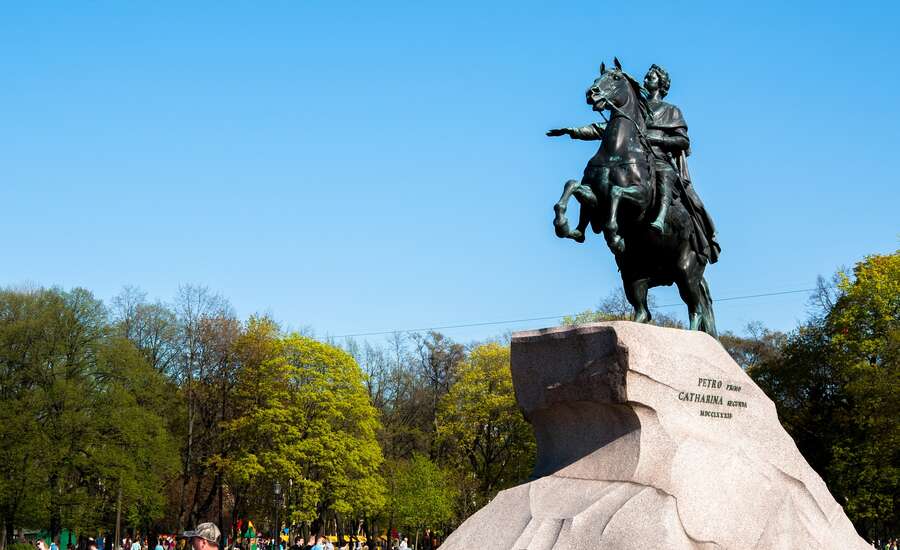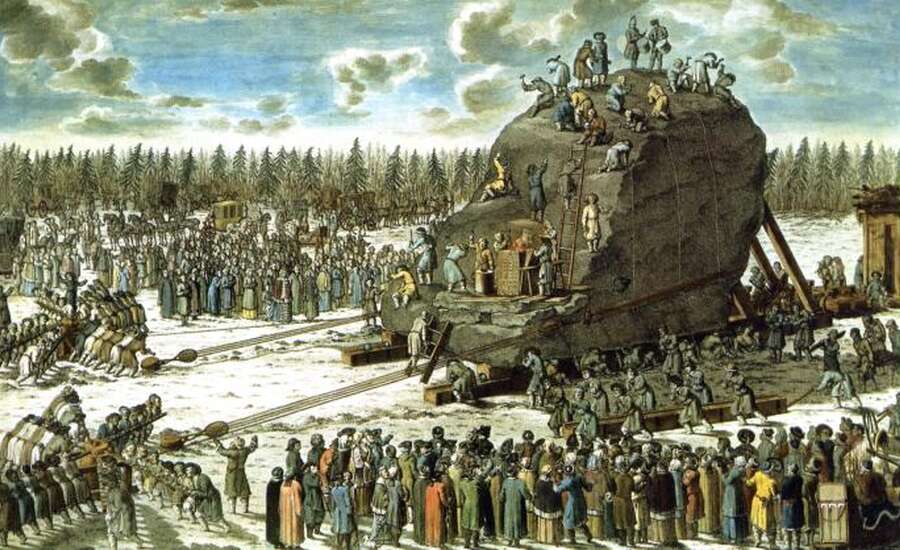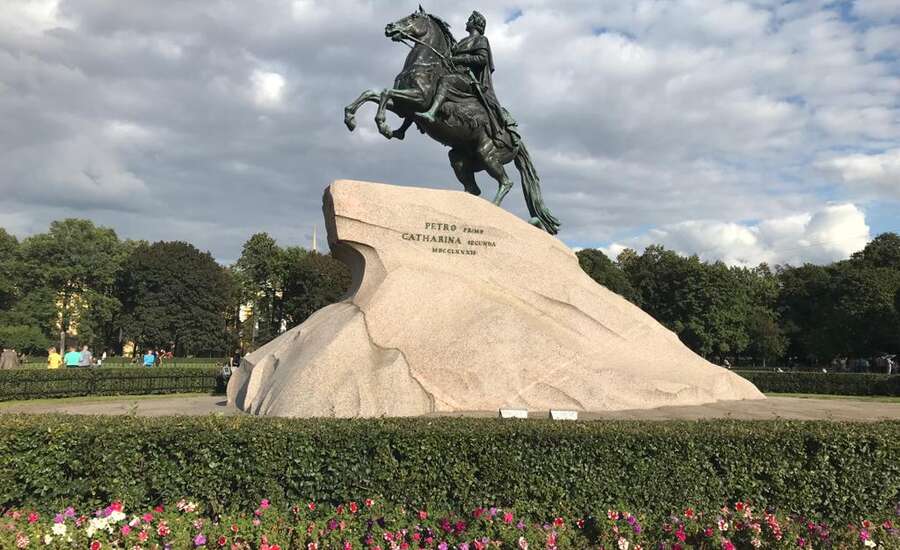The Bronze Horseman (Mednyi Vsyadnik) is a monument to Peter the Great on the banks of the River Neva. It is one of the key symbols of St Petersburg, immortalising the glory and power of the Russian state. The monument’s name makes reference to Alexander Pushkin’s eponymous poem, which embodies the mythical image of Peter the Great and St Petersburg through a tragic story of the great flood of 1824.

Photo by Сергей Горбачев from Pixabay
The Bronze Horseman monument was constructed by an international team between 1768 and 1782, comprised of sculptors Etienne Falconet, Marie-Anne Collot, and Fyodor Gordeev, foundry master Vasily Ekimov, and architect Yuri Felten. The chosen position for the statue was on Senate Square in front of the main legislative body of Tsarist Russia, the stately Neoclassical Senate Building. The 10-metre tall monument depicts Peter the Great atop a rearing horse, with his outstretched arm reaching towards the River Neva, and crushing a snake under the horse’s hoof. A colossal pedestal forms the base of the statue.
Did you know? Falconet was recruited by Catherine the Great on the recommendation of Denis Diderot and Voltaire, key philosophers of the Enlightenment and close correspondents of the empress.
The construction and erection of the Horseman was a true feat. Its pedestal is the largest stone ever moved by humans, known as the ‘Thunder Stone’. Transferring the 1,250-ton stone from its place of excavation in Lakhta to Senate Square took nearly 10 months, and involved transportation on a specially-built boat supported by two full-size warships. The stone was partially carved, but Catherine the Great forbade any further carving to maintain its natural appearance.
Did you know? Marie-Anne Collot, the sculptor of Peter the Great’s head, based her design on the sovereign’s death mask.
The monument was conceptualised by Catherine the Great, Diderot, and Voltaire. It would depict the victory of mankind over nature, the triumph of civilisation in Russia, and the success of Peter the Great; no theme could be more fitting to honour a man who built the Russian capital on frozen marshland in just a few years. The heroic figure of Peter the Great towering over the rough-cut base below it symbolised the trials which he overcame, and the snake being crushed under the horse’s hoof represented the enemies conquered by the Russian emperor. Catherine had engraved on the monument ‘From Catherine the Second to Peter the First’, to enshrine her connection to the legendary ruler and confirm her legitimacy as sovereign.
Did you know? Peter the Great’s motivation for building St Petersburg was to construct a ‘window onto Europe’, which would spearhead Russia’s transformation into a more European country. Peter was the first Russian tsar to visit Europe, and felt an intellectual connection to the West; his trips to Europe enriched his knowledge and profoundly influenced his thinking. It seems only fitting, then, that this statue of Peter the Great atop his horse faces towards Europe.
Thousands of citizens attended the unveiling of the monument on 7th August 1782, which was accompanied by a glorious military parade. To celebrate the opening of the monument, Catherine the Great issued a manifesto reprieving death sentences and corporal punishment, terminating criminal cases that had lasted over 10 years, and releasing those imprisoned for 10 years or more for debt reasons.

Engraving by I.F.Schley of the drawing by Y.M.Felten. 1770
Did you know? Legend has it that as long as the rider remains upon his pedestal, St Petersburg has nothing to fear. The Bronze Horseman remained in its place during the Patriotic War of 1812 and the Second World War, and St Petersburg stood strong despite these grave threats.
The Bronze Horseman takes its name from the eponymous poem written in 1833 by Alexander Pushkin. In The Bronze Horseman, Pushkin evokes the Petersburg Text: a literary construction which imagines St Petersburg as a place of mythical origin which is defined by contrasts; a place whose existence defies all expectations and which withstands anything that befalls it.
The poem opens with the foundation myth of St Petersburg, characterising it as a city which rose from uninhabited wilderness by the sheer strength of mankind, and which exists as the physical embodiment of its heroic founder. The narrator shows his love for the city and its beauty and strength, presenting a mythologised view of reality.
Yet the natural forces which were subdued by Peter return with a vengeance, in the devastating flood of 1824. The poem tells the story of a poor Petersburg official, Evgeniy, whose beloved is killed by the flood. Driven mad with grief, Evgeniy curses the monument to Peter the Great, seeing him as the cause of all his sufferings. In response to Evgeniy’s challenge, the statue jumps from its pedestal and chases him around the city. Whilst Evgeniy dies of madness a few months later, the monument to Peter the Great stands triumphant above the flooded city, and will remain there long after the flood recedes.
These conflicts between Tsar and citizen, order and disorder, and mankind and nature are central to The Bronze Horseman, and are embodied in Pushkin’s poetic depiction of the monument to Peter the Great. Following the publication of the poem in 1837, people began referring to the monument as ‘the Bronze Horseman’ – a symbol of the Russian state where historical and cultural myths traverse the boundaries between reality and legend.
No visit to St Petersburg would be complete without admiring this monument to the founder of the city, and feeling the atmosphere of this magical place. Visiting the Bronze Horseman is completely free of charge. It stands just a few minutes’ walk from other of St Petersburg’s most famous landmarks.

Photo by Express to Russia staff
Essential information for visitors
Address and contact details
Senate Square, St Petersburg, 190000
Nearest metro: Admiralteyskaya (900m)
Opening hours
24/7!
Join us on Facebook
We invite you to become a fan of our company on Facebook and read Russian news and travel stories. To become a fan, click here.
Join our own Russian Travel, Culture and Literature Club on Facebook. The club was created to be a place for everyone with an interest in Russia to get to know each other and share experiences, stories, pictures and advice. To join our club, please follow this link.